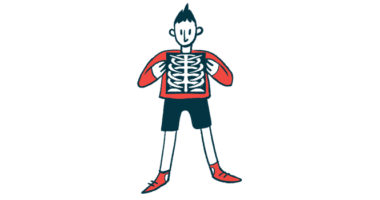Early Spinraza Treatment Improves Outcomes of Children with SMA, Study Shows

Young children with spinal muscular atrophy (SMA) show improvements in motor function after six-months of treatment with Spinraza (nusinersen), a German study shows.
The response to Spinraza strongly correlated with the age when treatment began, with children treated before seven months of age responding better to the therapy.
These findings support the need for early detection of SMA by screening newborns, study authors emphasized.
“Our findings add to the increasing body of evidence that early diagnosis and initiation of treatment is fundamental for patients with infantile-onset spinal muscular atrophy,” Janbernd Kirschner, MD, study lead author, said in a press release. Kirschner is the coordinator of the TREAT-NMD Clinical Trial Coordination Centre (CTCC) in Freiburg, Germany.
The study, “Evaluation of Children with SMA Type 1 Under Treatment with Nusinersen within the Expanded Access Program in Germany,” was published in the Journal of Neuromuscular Diseases.
Spinraza, developed by Biogen, is the first FDA-approved drug for SMA.
Join the SMA forums and be part of the conversation about Spinraza.
SMA arises due to mutations in the survival motor neuron 1 (SMN1) gene, which is key to the function and survival of the nerves that control muscles. Some patients, however, maintain a copy of a gene called SMN2, a gene nearly identical to SMN1 that can give rise to a shorter version of the SMN protein.
Spinraza boosts the amount of the SMN protein by increasing the levels of full-length messenger RNA (mRNA), the mediator between gene and protein, generated by the SMN2 gene.
Spinraza is administered via intrathecal injection — directly to the cerebrospinal fluid around the spinal cord, where motor neurons of SMA individuals degenerate due to insufficient levels of SMN protein.
The therapy was approved in the U.S. in December 2016 to treat SMA types 1–3 in children and adults, and learned approval in Europe in June 2017.
Access study in Germany
Prior to the EU’s approval, a group of children in Germany with SMA type 1 was given access to Spinraza for seven months, under an Expanded Access Program (EAP). The children had different ages and were at different stages of the disease, representing a more heterogenous group than those in previous trials.
Researchers analyzed data from 61 children treated with Spinraza in seven centers under the EAP. Children enrolled in the study developed the first symptoms of SMA before the age of 6 months and had no ability to sit independently.
Moreover, 38 children (62.3%) had less than two copies of the SMN2 gene, and 20 children had more than three copies. In three children, the SMN2 copy number was unknown.
Previous studies showed that a higher number of SMN2 correlates with longer survival and inversely with disease severity.
Administration of Spinraza was performed on days 1, 15, 30, 60 and 180.
Researchers measured the treatment outcomes by assessing primarily the changes from the beginning of the study in the score of the Children’s Hospital of Philadelphia Infant Test of Neuromuscular Disorders (CHOP INTEND), which measures motor function.
The CHOP-INTEND scores range from 0 to 64 points and previous studies have reported that children with SMA type 1 have a mean value of 21.4 points. The test was performed at the beginning of the study, then after 60 days, and at the end of treatment (180 days).
Additionally, they assessed changes in scores in section 2 of the Hammersmith Infant Neurological Examination (HINE) scale, another test measuring motor function, whose scores range between zero and 26. The HINE-2 was performed routinely at every patient visit.
“Furthermore, we evaluated changes in respiratory and nutritional status as well as parents’ impression regarding improvements or worsening in motor and respiratory function,” they wrote.
At baseline, children’s mean CHOP INTEND score was 22.3 and after six months of treatment the mean score improved to 31.2, which was an increase of nine points. Specifically, eight children improved by one to four points, and 17 children improved by five to nine points.
Sixteen children improved by more than 10 points (between 10 and 14 points), and 11 children underwent an increase on the CHOP INTEND by more than 15 points.
Children with less than two copies of the SMN2 gene had lower scores in the CHOP INTEND at the beginning of the trial. The changes in scores after treatment were comparable to children with more than three SMN2 copies, scores of 8.1 and 8.2, respectively.
Treatment was more effective in younger children (aged below 7 months) compared to older ones — an improvement of 14.4 vs. 7.0, respectively.
Interpreting the results
These results suggest there is a “critical therapeutic time window for delivery of SMN-targeted therapies,” said Kirschner. “The implementation of newborn screening for SMA is crucial to allow pre-symptomatic diagnosis.”
Regarding the motor response, 19 children improved by more than two points in HINE-2 motor milestones — 15 children increased their score by two to four points, and four children by more than five points.
“Four children (6.6%) achieved full head control, and 2 children (3.3%) were able to sit independently,” researchers wrote.
After six months of treatment, the parents of 28 children reported a marked improvement in motor function, while three parents noticed no benefit, and one a slight worsening.
Respiratory function was improved in 16 children, with a marked improvement in four of them.
Overall, these findings “indicate that even in advanced stages of the disease, Spinraza can lead to improvement of motor function as measured by CHOP INTEND,” researchers wrote.
Moreover, the results support early diagnosis and access to Spinraza as early as possible as a key factor to improve the outcomes of children with SMA.
Researchers now will evaluate whether increasing the treatment period with Spinraza enhances the therapy’s benefits and patients’ quality of life. The data will be collected within the SMArtCARE project, a “real-world data” registry of SMA patients.







